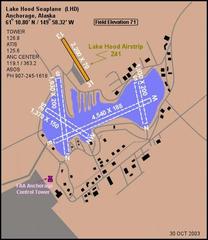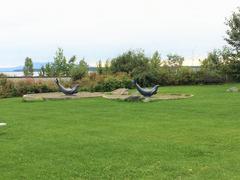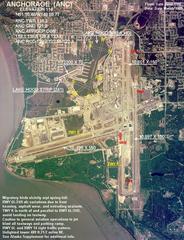Flying Crown Airport Anchorage: Visiting Hours, Tickets, and Travel Guide
Date: 14/06/2025
Introduction: A Unique Anchorage Airfield
Flying Crown Airport (FAA identifier: AK12) is a distinctive and historic airstrip nestled within a residential subdivision in southern Anchorage, Alaska. Established in the post-World War II era, this privately owned, public-use airfield is a testament to Alaska’s deep reliance on general aviation, serving as a hub for private pilots and aviation enthusiasts. With its modest facilities, single gravel runway, and integration into a residential neighborhood, Flying Crown embodies the pioneering spirit of Alaskan bush pilots and the community-driven ethos that defines much of the state’s aviation culture.
Unlike the nearby Ted Stevens Anchorage International Airport—one of the world’s busiest cargo hubs (Simple Flying)—Flying Crown caters to a smaller, specialized aviation community. Its role is complemented by Anchorage’s other notable aviation sites, such as the bustling Lake Hood Seaplane Base and the Alaska Aviation Heritage Museum, both key destinations for those interested in Alaska’s aviation legacy (Anchorage.net; Mountain States Legal Foundation).
Contents
- History and Early Development
- Anchorage’s Aviation Network and Flying Crown’s Role
- Infrastructure and Facilities
- Visiting Hours, Access, and Permissions
- Unique Features and Visitor Experience
- Safety and Operational Guidelines
- Legal Challenges and Community Impact
- Nearby Attractions and Activities
- Transportation, Weather, and Accommodations
- Practical Tips and Frequently Asked Questions (FAQ)
- Visuals and Resources
- Summary and Final Tips
- Official Sources and Further Reading
History and Early Development
Flying Crown Airport was developed in the mid-20th century, paralleling the growth of Anchorage and the increasing importance of aviation for connecting Alaska’s remote communities. Originally established by aviation enthusiasts and local residents, the airport reflects a tradition of small, community-oriented airstrips that made reliable travel possible in Alaska’s challenging terrain.
The name “Flying Crown” evokes the pioneering spirit of private pilots and bush flyers who helped shape Alaska’s aviation history. While the airport’s facilities remain modest, its continued operation underlines the enduring value of general aviation in the region.
Anchorage’s Aviation Network and Flying Crown’s Role
Anchorage is renowned for its rich aviation infrastructure. While commercial and cargo operations are centered at Ted Stevens Anchorage International Airport (Simple Flying), smaller airfields like Flying Crown play a vital role in supporting private pilots, flight training, and recreational flying.
Flying Crown Airport provides an alternative to busier public airports, reducing congestion and fostering a close-knit community of aviation enthusiasts. Its location within the city ensures easy access to both urban amenities and the Alaskan wilderness, making it a strategic point for launching outdoor adventures.
Infrastructure and Facilities
Flying Crown Airport features:
- Runway: A single gravel surface (13/31), approximately 2,100 feet long, suitable for small, general aviation aircraft.
- No Control Tower: Operations are conducted under visual flight rules (VFR).
- Facilities: No terminal building, fuel services, or maintenance facilities. Hangar and tie-down spaces are reserved for residents and authorized users (City-Data).
- Self-Sufficiency: Pilots are responsible for their own flight planning, fueling (prior to arrival), and maintenance.
Visiting Hours, Access, and Permissions
Flying Crown Airport is private and does not have public visiting hours or ticketing services. All landings and visits require Prior Permission Required (PPR), which must be arranged through the Flying Crown Subdivision Property Owners Association or individual property owners.
Access Guidelines
- No Walk-In Visits: Unauthorized landings or visits are strictly prohibited.
- Permission Process: Contact the property owners association well in advance to request access or landing permission.
- Events: Occasional community fly-ins and aviation events may offer limited public access; check with local aviation groups for schedules.
Unique Features and Visitor Experience
While not a commercial tourist destination, Flying Crown Airport appeals to aviation enthusiasts for its:
- Residential Airpark Setting: One of the few airfields where residents live with direct airstrip access.
- Grassroots Aviation Culture: Regular fly-ins, flight training, and social gatherings that maintain Anchorage’s flying traditions.
- Backcountry Access: A launch point for private or charter flights into Alaska’s wilderness.
Tip: Always respect community privacy and adhere to airport rules when visiting.
Safety and Operational Guidelines
- Visual Flight Rules: Pilots must coordinate arrivals and departures visually; there is no air traffic control.
- Weather: Alaska’s rapidly changing weather requires pilots to check METARs, TAFs, and NOTAMs before flying.
- Facilities: No fuel, food, or emergency services on site—plan accordingly.
- Wildlife: Occasional sightings of moose or other wildlife on or near the runway—exercise caution.
Legal Challenges and Community Impact
The Alaska Railroad Dispute
Flying Crown Airport’s proximity to the Alaska Railroad Corporation’s (ARRC) right-of-way has led to significant legal challenges. In 2020, ARRC asserted exclusive easement rights, restricting aviation activities across the railroad corridor. The Flying Crown Subdivision Property Owners Association, represented by the Mountain States Legal Foundation, challenged these claims. However, federal courts upheld ARRC’s easement, and the Supreme Court declined to review the case in 2024 (Mountain States Legal Foundation).
Impact:
- Restricted aviation activity on the easement.
- Ongoing uncertainty for property owners and pilots.
- Increased necessity for compliance with railroad and municipal regulations.
Nearby Attractions and Activities
Visitors to Anchorage can enjoy a range of attractions near Flying Crown Airport:
- Alaska Aviation Heritage Museum: Exhibits on Alaska’s aviation history, vintage aircraft, and flight simulators (Alaska Aviation Heritage Museum).
- Lake Hood Seaplane Base: The world’s busiest seaplane base, with daily floatplane activity (Anchorage Travel Guide).
- Tony Knowles Coastal Trail: 11 miles of coastal biking and walking trails (Emergent One).
- Earthquake Park: Interpretive trails and views of Cook Inlet (Emergent One).
- Chugach State Park: Hiking, wildlife, and panoramic views (Anchorage.net).
- Downtown Anchorage: Museums, shops, and restaurants (Anchorage.net).
Transportation, Weather, and Accommodations
Getting Around
- No Public Transit: Rental cars, taxis, and rideshares (Uber/Lyft) are recommended.
- Parking: Limited to residents and authorized users at the airstrip.
Weather
- Summer: 60–70°F (15–21°C), long daylight hours.
- Winter: 5–20°F (-15 to -6°C), snow and ice may affect runway conditions.
Accommodations
- No Onsite Lodging: Anchorage offers hotels, B&Bs, vacation rentals, and hostels within easy reach.
Practical Tips and Frequently Asked Questions (FAQ)
Q: Can I visit Flying Crown Airport as a tourist?
A: No, access is private and by prior permission only.
Q: Are there tickets or entry fees?
A: No tickets or fees; access is limited to authorized pilots and guests.
Q: What types of planes use the airstrip?
A: Small general aviation aircraft, typical of Alaska bush flying.
Q: Is fuel available?
A: No; plan to fuel before arrival.
Q: What’s the best way to explore Anchorage?
A: Rent a car, especially for reaching parks and museums.
Visuals and Resources
For an enhanced experience, visitors are encouraged to browse:
- High-quality images of Flying Crown Airport and Anchorage’s aviation landmarks.
- Interactive maps showing airport location and surrounding attractions.
- Virtual tours of the Alaska Aviation Heritage Museum.
Summary and Final Tips
Flying Crown Airport is a unique embodiment of Anchorage’s aviation heritage—a rare community where residential life and flying intersect. While access is highly restricted and legal challenges have introduced operational uncertainties, the airport remains an important cultural landmark for Alaska’s general aviation community. Pilots and visitors must secure advance permission, plan for limited facilities, and keep abreast of weather and legal updates.
Anchorage’s rich mix of aviation history, outdoor adventure, and cultural attractions offers ample opportunities for exploration beyond the airport itself. Careful preparation will ensure a safe and rewarding visit.
For ongoing updates, travel tips, and in-depth Anchorage guides, download the Audiala app and follow local aviation communities on social media.
Official Sources and Further Reading
- Simple Flying – Busiest Alaskan Airports
- City-Data: Flying Crown Airport Information
- Anchorage.net: Visitor Guide
- Mountain States Legal Foundation: Flying Crown Case
- Alaska Aviation Heritage Museum
- Anchorage Travel Guide
- Emergent One: Things to Do in Anchorage
- Visit Anchorage: Flying In
- Anchorage Museum
- PlanetWare: Anchorage Attractions
- TripJive: Explore Cultural Experiences in Anchorage




